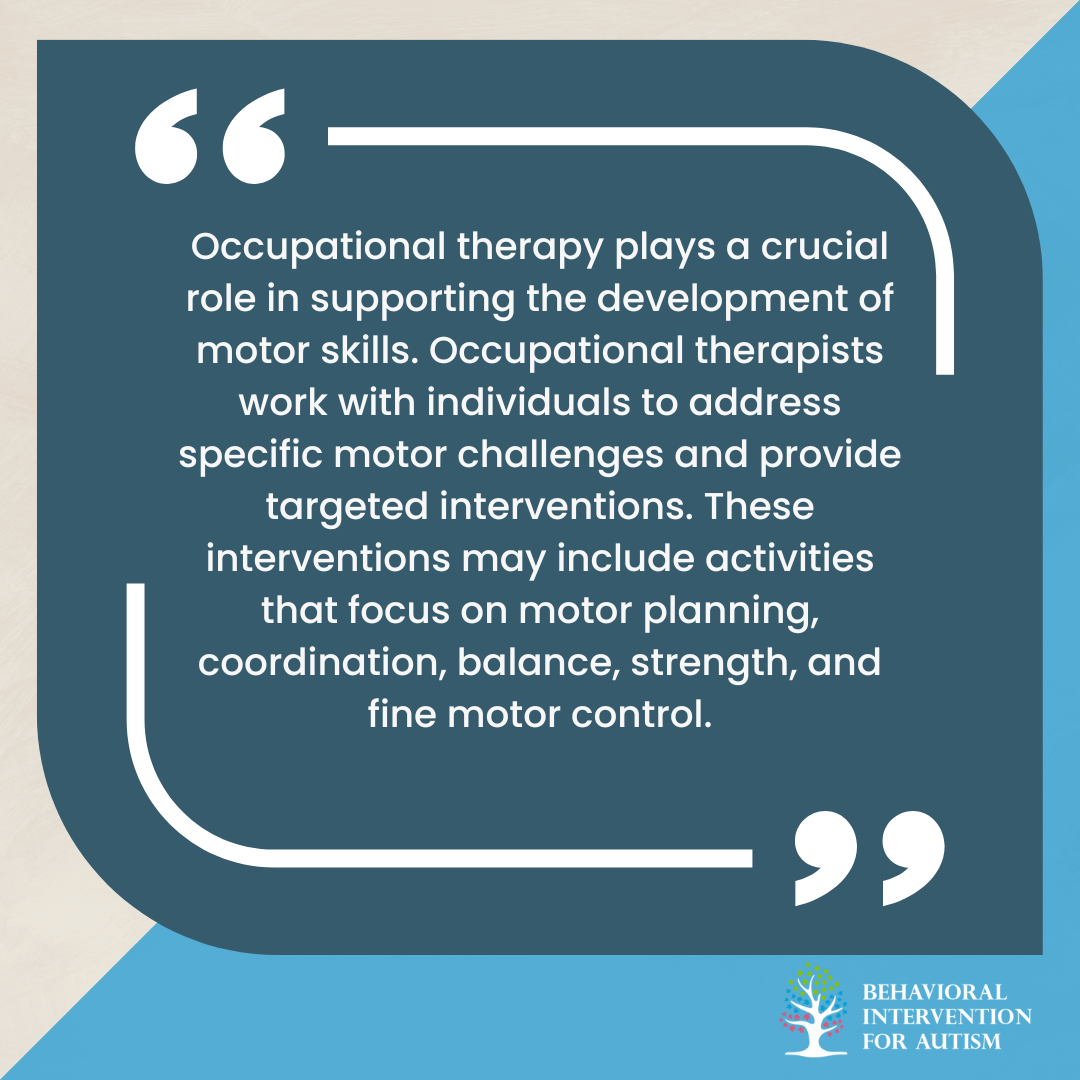
Table of Contents
Motor planning, also known as praxis, refers to the ability to plan and execute motor tasks required for daily activities. It involves knowing, remembering, and performing the small steps necessary to complete a movement or task.
For individuals with autism, motor planning difficulties can pose challenges in various aspects of their lives.
In case you’re wondering, motor planning is essential for determining how the body will move, the steps to be taken, and the order in which they should occur. It plays a crucial role in performing simple tasks like brushing teeth or tying shoelaces, as well as more complex activities such as playing sports or doing crafts.
Without effective motor planning skills, individuals may struggle to initiate, organize, and execute these tasks.
Signs of Motor Planning Difficulties
Children with autism who have difficulties with motor planning may exhibit several signs that can vary in severity and presentation. Here are some of its most common signs:
- Clumsiness – They may appear awkward or uncoordinated in their movements, often tripping or bumping into objects.
- Difficulty coming up with new play ideas – They may struggle to generate novel ways of playing or engaging in imaginative activities.
- Slow learning of new skills – It may take them longer to acquire and master new motor skills compared to their peers.
- Fine motor skill challenges – They may struggle with tasks that require precise control of small muscles, such as writing or buttoning clothes.
- Inconsistent performance with daily tasks – They may exhibit variability in their ability to perform daily activities, sometimes completing them successfully and other times struggling.
- Trouble imitating actions – They may find it difficult to imitate or replicate movements demonstrated by others.
- Avoidance of physical activities – They may show a preference for sedentary activities and avoid or resist engaging in physical play or exercise.
Recognizing these signs can help caregivers and professionals identify motor planning difficulties in individuals with autism. Early intervention and appropriate support can help address these challenges and promote motor skill development.
Factors Contributing to Motor Difficulties
Motor difficulties are commonly observed in individuals with autism, and these can impact their ability to plan and execute movements effectively.
There are two key factors that contribute to these challenges which are as follows:
Brain Wiring Differences
Children with autism often exhibit differences in brain wiring, which can affect various aspects of motor functioning. These differences can influence motor learning, coordination, prediction, anticipation, postural stability, balance, joint hypermobility, and muscle strength.
As a result, individuals with autism may struggle with tasks that require precise motor control and coordination.
Sensorimotor Integration Challenges
Sensorimotor integration refers to the ability to process sensory information and coordinate it with motor responses.
In individuals with autism, sensorimotor integration difficulties can hinder the smooth execution of motor tasks. These challenges may manifest as delays or deficits in motor skills development, coordination difficulties, and difficulties with activities that require fine motor control.
Development of Motor Skills in Autism
Children with autism may face challenges in the development of their motor skills. Motor skills encompass both gross motor skills, involving larger muscle groups and whole-body movements, and fine motor skills, which involve precise movements of the hands and fingers.
These skills are essential for daily activities, such as dressing, eating, and writing.
Challenges in Motor Skill Acquisition
Children with autism may experience difficulties in acquiring motor skills due to various factors. Motor planning can be particularly challenging for individuals with autism. It also allows individuals to know, remember, and perform the small steps required to complete a movement or task.
Difficulties in motor planning can affect tasks such as brushing teeth, tying shoelaces, or using utensils.
Strategies for Skill Improvement
Despite the challenges, there are strategies that can help improve motor skills in children with autism.
In addition to professional therapy, there are activities that parents and caregivers can incorporate into daily routines to support motor skill improvement. These activities may include:
- Providing opportunities for physical play and exercise, such as climbing, jumping, and running, to enhance gross motor skills.
- Encouraging activities that promote fine motor control, such as puzzles, threading beads, and drawing.
- Using tools and aids that assist with motor tasks, such as adaptive utensils for eating or pencil grips for writing.
- Breaking down complex tasks into smaller, more manageable steps to support motor planning.
- Creating a supportive and structured environment that allows for repetition and practice of motor skills.
Role of Repetition in Skill Development
Repetition plays a significant role in the development of motor skills for children with autism. Through repeated practice, the brain forms new connections and strengthens existing ones, enhancing motor skill acquisition. Consistency and repetition help to reinforce the neural pathways involved in motor planning and execution.
By providing regular opportunities for practice, children with autism can improve their motor skills over time.
That said, it is important to create a supportive and encouraging environment that allows for repetition without excessive pressure. Celebrating small achievements and providing positive reinforcement can further motivate and engage individuals in their motor skill development journey.
Intervention Strategies for Motor Skills
Intervention strategies play a vital role in promoting skill development and enhancing the overall quality of life of autistic individuals. There are two effective approaches in this regard, namely:
Occupational Therapy
Occupational therapists (OT) play a crucial role in helping children with Autism Spectrum Disorder (ASD) improve their motor skills. These therapists are trained to identify delays in fine motor skills and address various factors contributing to motor difficulties, such as motor planning, posture, low tone, visual motor integration skills, and sensory processing difficulties.
Through individualized interventions, occupational therapists target specific areas of need and focus on enhancing skills related to daily tasks such as dressing, self-care, grooming, feeding, writing, and drawing.
By working on these essential activities, occupational therapy helps individuals with autism develop the necessary motor skills to navigate their daily lives with increased independence and confidence.
Sensory Integration Therapy
Sensory integration therapy has gained recognition for its effectiveness in improving motor skills in children with autism. This therapy focuses on addressing sensory processing issues commonly experienced by individuals with autism, helping them better integrate sensory input and enhancing coordination and motor planning.
By providing a structured environment and engaging in sensory-rich activities, sensory integration therapy aims to help individuals with autism develop a more organized and efficient sensory system. This, in turn, can lead to improvements in motor skills and coordination.
Combining sensory therapy with traditional motor skills training can accelerate progress and offer a holistic approach to motor skill development.
Importance of Early and Consistent Therapy
Early intervention is crucial for maximizing the potential for motor skill development in individuals with autism. Starting therapy as early as possible allows for targeted interventions during critical periods of development when the brain is most receptive to learning and creating new neural connections.
Consistency in therapy is also essential. Regular and ongoing occupational therapy sessions provide individuals with autism the opportunity to practice and reinforce newly acquired motor skills.
This consistency helps solidify these skills and promotes generalization to real-world situations.
By utilizing occupational therapy and sensory integration therapy, individuals with autism can make significant strides in improving their motor skills. These interventions, when implemented early and consistently, have the potential to enhance life skills, foster independence, and improve the overall quality of life for individuals with autism.
At Behavioral Intervention for Autism, we offer high-quality ABA therapy in Florida and help equip parents with the knowledge they need to advocate for their child’s needs. Get in touch to learn more and start making a positive impact on your child’s development.
Sources:
https://www.autism.org.uk/advice-and-guidance/professional-practice/motor-skills-1
https://www.thetransmitter.org/spectrum/motor-difficulties-in-autism-explained
https://www.autismparentingmagazine.com/autism-children-motor-planning
https://www.mywellnesshub.in/blog/motor-developmental-difficulties-in-autistic-children
- 9 Common Obsessions of Children With Autism You Should Know - February 25, 2025
- What is Neurodiversity? A Guide to Embracing Differences - February 25, 2025
- Understanding Hyperfocus in Autism: What It Means and Why It Happens - February 25, 2025





